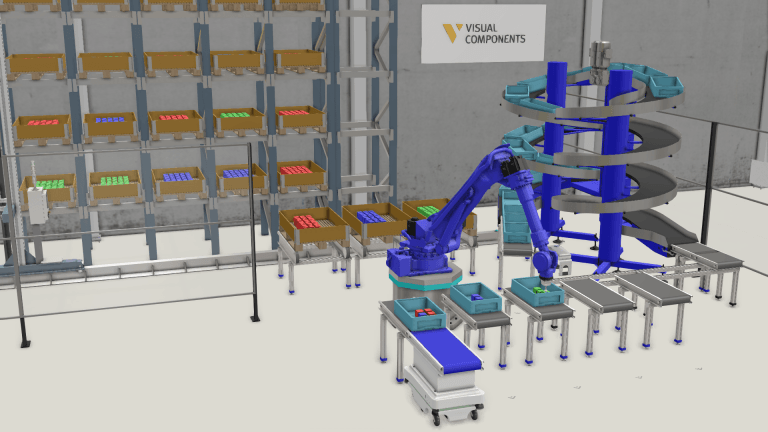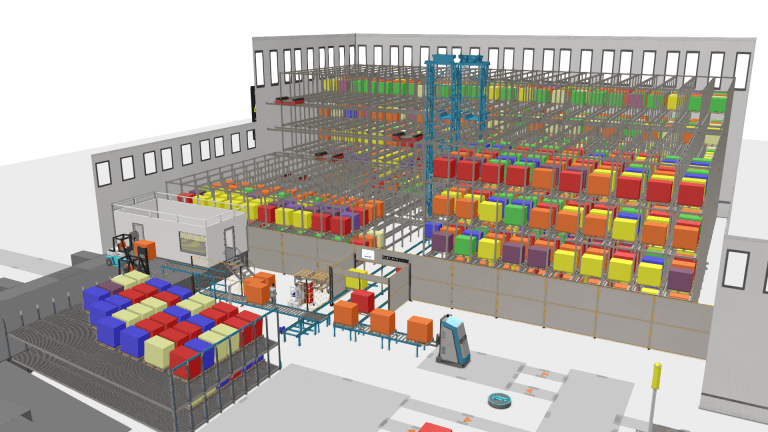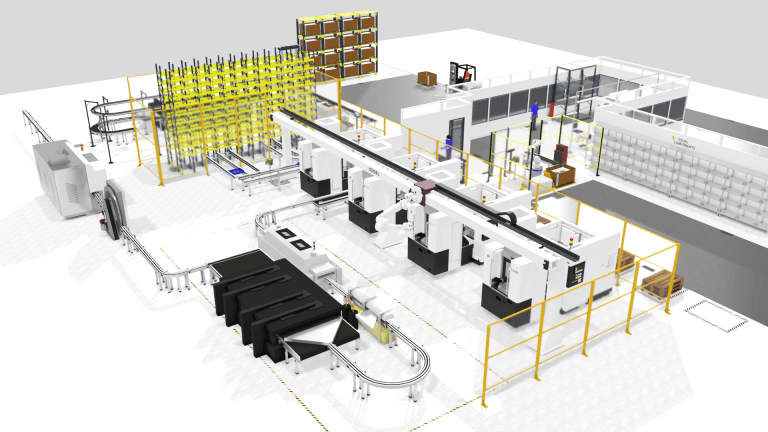It is Time for 3D Manufacturing Simulation (Videos included)
Everything about manufacturing is complicated. That’s what makes it hard to run production operations, and harder still to design, plan and implement new equipment, layouts and processes. 3D manufacturing simulation is a powerful tool for analyzing, planning, optimizing and improving factory layouts, machinery and organization.
Reconfiguring production lines and investing in automation and new equipment carries significant risk. What will happen if the product mix turns out different from what’s expected, or a previously unseen bottleneck constrains output? What if cycle times are longer than expected or transport systems move slower?
If any of these occur the projected ROI and payback won’t be achieved. At a minimum, that will make decision-makers less likely to sign off on future proposals.
Visual Components 3D manufacturing simulation software helps reduce this risk. It’s a tool for developing better solutions, and for communicating those solutions to decision-makers and others. Here’s what you should know about it.
- What is 3D Manufacturing Simulation?
- Why Visual Components?
- Business Benefits of 3D Manufacturing Simulation
- What Kind of Challenges can 3D Manufacturing Simulation Help With?
- How Can You Avoid Costly Mistakes?
- De-Risk Capital Spending – Avoid Making Capital Investment Mistakes
- How Can System Integrators Benefit from 3D Manufacturing Simulation?
What is 3D Manufacturing Simulation?
Picture a digital representation of your factory, production line, or cell. That’s the start, but with 3D manufacturing simulation the digital model doesn’t just look like the real thing, it functions like it too. Orders are processed, machines and robots run, and parts and materials move through this digital system just as they do in the real world.
Forward-thinking manufacturing companies use this tool to help them make fast, fact-based decisions about their future manufacturing processes. It’s a “must-have” tool for planning and managing every aspect of the production system lifecycle, from conceptual design to performance analysis. Using 3D manufacturing simulation, manufacturers can check capacity, determine lead times, model “what-if” scenarios and compare alternative machine layouts and workflows.
Why Visual Components?
With 3D manufacturing simulation software from Visual Components, it’s possible to model almost every type of manufacturing operation. Our software can bring in models from any CAD package and can work with all robot programming and PLC simulation tools: it’s completely agnostic, meaning there are no barriers to what you can import to your 3D simulation.
When prospective customers ask how they’d use our software we have an extensive list of use cases to draw on. These include material flow analyses, sketching conceptual layouts, robot work cycle planning, PLC validation, and even immersive virtual reality.
Business Benefits of 3D Manufacturing Simulation
3D manufacturing simulation software is a tool for finding improvements and calculating ROI and payback. It’s also a tool that speeds up your work. For example, sketching conceptual layouts is five times faster than CAD.
You could use the time saved in various ways, but many manufacturers spend it performing more analyses, making more comparisons, and evaluating more alternatives. That avoids costly mistakes in automation investment and leads to better solutions, with higher capital, space, and equipment utilization.
Improvements our customers tell us they see include:
- Up to 30% improvement in manufacturing efficiency
- 15% reduction in total project cost
- Throughput increased 25%
3D manufacturing simulation isn’t just a tool for Engineering and Operations though. It’s also a tool that lets business leaders see where the dollars are being spent and how they will be earned back.
What Kind of Challenges can 3D Manufacturing Simulation Help With?
When asked this question, we start with the more common applications. For example:
- Sketching conceptual layouts
- Optimizing floor space utilization
- Working out how to fit production layouts or equipment into brownfield sites
- Planning layouts for greenfield factories
These are all excellent uses, and yet they are only the tip of the iceberg. An application that yields very significant benefits is evaluating changes in the product mix. This is especially valuable as part of a new product launch. In such cases, 3D manufacturing simulation is used to explore how product mix affects workflows, bottlenecks, and capacities.
Many manufacturers are interested in how their production system behaves under pressure, such as during periods of peak production. In this use case simulation often highlights issues that would never be discovered by modeling in Excel or relying on experience and judgment.
Another way of using manufacturing simulation is to generate facts to support decisions made regarding the management of production operations. Good examples are looking at whether you will be able to meet promised delivery dates and providing data that lets you make on-time delivery promises. Want to state that 99% of orders will ship on time? 3D manufacturing simulation can give you the confidence to do that, knowing that you won’t disappoint your customers.
How Can You Avoid Costly Mistakes?
3D simulation software is a powerful tool for evaluating complex new production systems and automation. This is illustrated by looking at the example of a robot cell. The robot might be palletizing, machine tending, or arc welding – the type of application doesn’t matter.
Many companies do the programming on the robot using a teach pendant. Others prefer offline programming using proprietary tools provided by the robot vendor. Both methods are slow, and both ignore how the robot is part of a larger system.
An alternative is to use the very effective offline robot programming tools available from Visual Components. Working in the office rather than the factory floor, and only bringing the program to the robot when it’s ready, minimizes production disruption and enables higher-quality programming.
This is a valuable improvement, but there’s more. The robot is just one piece of a bigger puzzle, the rest being up and downstream of the robot. Maximizing output at the robot requires understanding if there’s a bottleneck elsewhere. Perhaps an upstream operation can’t keep up, or maybe a downstream process can’t handle the full output the robot can supply.
This is the kind of big picture view you can get with Visual Components. By helping you identify and focus on the important areas you’re able to make better investment decisions that maximize production system performance.
De-Risk Capital Spending – Avoid Making Capital Investment Mistakes
Without 3D manufacturing simulation, it’s extraordinarily difficult to plan and manage every detail of a complex capital equipment project. Too often the omissions, oversights, and incorrect assumptions only come to light after the buildings are constructed and the equipment installed. Of course, by that point making changes is very expensive and it may be less costly to accept suboptimal performance, despite the financial impact that brings.
With Visual Components software, you construct your equipment, production cells, lines, and even entire factories on the screen rather than on the shop floor. This saves time and money and avoids the frayed nerves that result from making adaptions on-the-fly. Simulation results in better project plans, better manufacturing processes, better products, and happier customers.
3D manufacturing simulation is the tool that helps you reach these goals. Think of it as a kind of insurance. If you have a big investment project you should be using it. It will increase the success of the project and will give you the adding security of knowing you have a Plan B in your back pocket.
How Can System Integrators Benefit from 3D Manufacturing Simulation?
3D manufacturing simulation isn’t just a tool for manufacturers. It’s an essential tool for industrial automation system integrators. Any that aren’t already using simulation should start doing so immediately!
For integrators, it dramatically accelerates the conceptual layout design process. This means you can present new layouts and ideas to your customer immediately rather than waiting two weeks for a designer to have time to work on them.
With Visual Components sales, professionals or applications engineers can produce conceptual layouts on the spot. Using eye-catching visuals and graphics will get your customer excited about what your business can offer them.
Quality graphical displays will also help you reach out to the right people on the customer side – the Managers, Directors, and Vice Presidents that recommend and make the investment decisions. They want to understand what they are being asked to spend, and what they will get for the money.
Effective and visual 3D simulation is a tool for capturing their attention and getting them interested in your proposal. It helps accelerate the sales process, it increases customer commitment and it helps you improve your hit rate when talking with those customers and winning their business.
Analysis, Explanation, and Persuasion
Everything about manufacturing is complicated. That’s what makes it hard to run production operations, and harder still to design, plan and implement new equipment, layouts and processes.
3D manufacturing simulation is a powerful tool for analyzing, planning, optimizing, and improving factory layouts, machinery, and organization. It’s also an extremely effective means of communicating proposals, securing support, and winning new business. Experts at Visual Components would like to tell you more.
Further reading

Optimizing production lines the smart way with simulation
Manufacturers are always looking for ways to improve, whether it’s increasing throughput, reducing bottlenecks, or making better use of resources. But optimizing production lines can get complicated without the right...

Smarter warehouse planning starts with simulation
How can businesses design warehouses that operate efficiently from day one while keeping labor costs and other expenses in check? The key is smart planning and validation with simulation tools...

Comprehensive guide to input data for 3D manufacturing simulation (examples included)
If you're new to 3D manufacturing simulation, you're in the right place. This comprehensive guide will help you understand the essential input data needed to create effective simulation models. Whether...